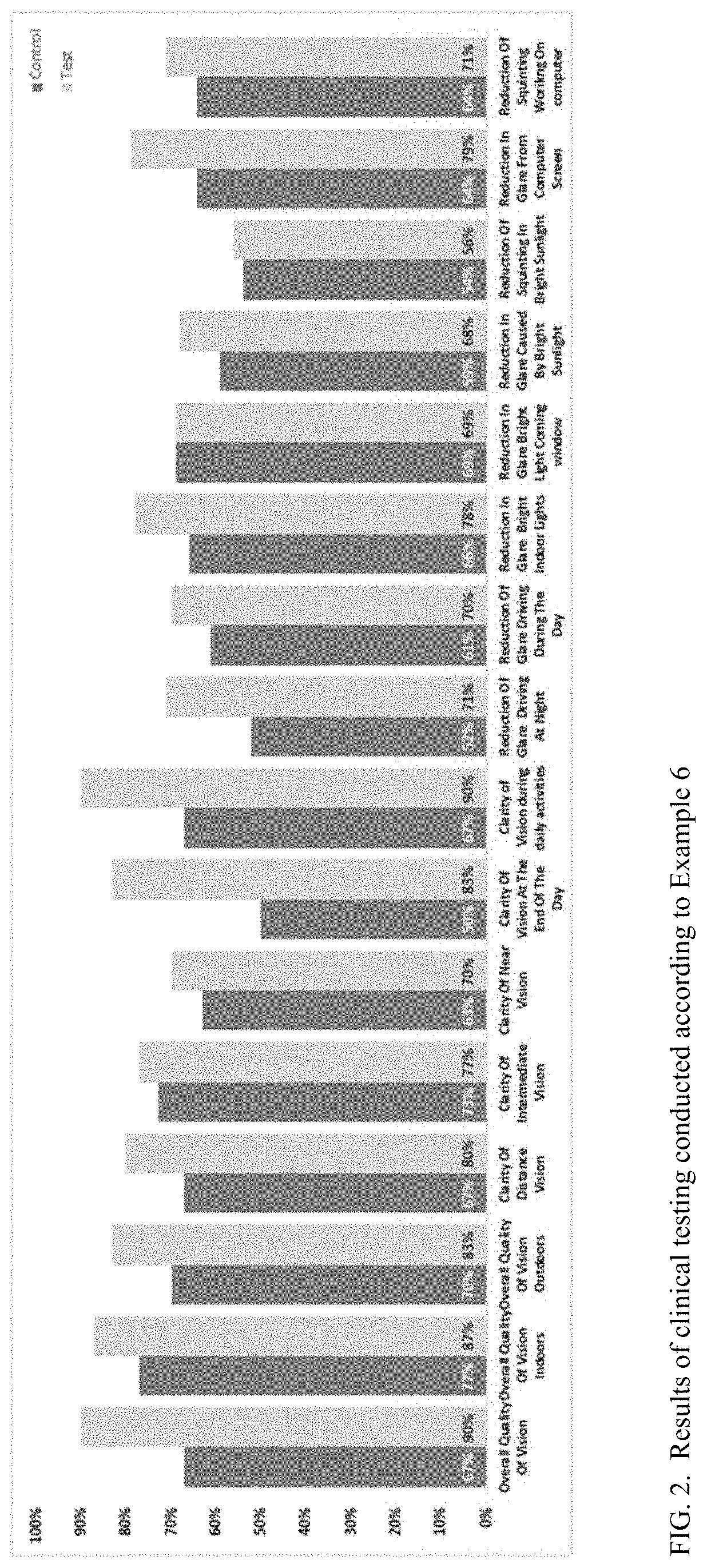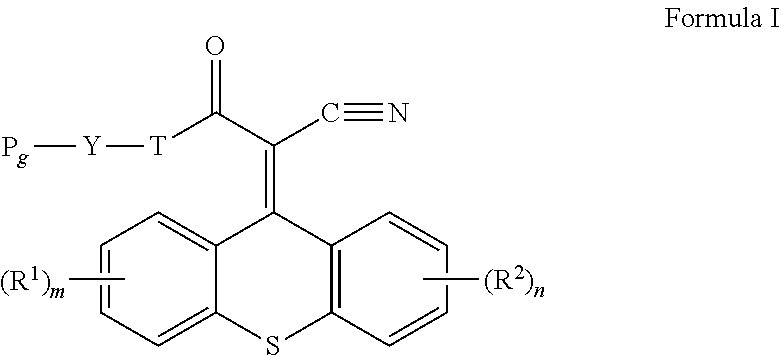Multifocal contact lens displaying improved vision attributes
a multi-focal, contact lens technology, applied in the field of multi-focal contact lenses, can solve the problems of less able to accommodate, bending of natural or crystalline lenses, crystalline lenses becoming more rigid, etc., to improve the amount of high-energy visible light absorbing compounds, improve the effect of vision attributes
- Summary
- Abstract
- Description
- Claims
- Application Information
AI Technical Summary
Benefits of technology
Problems solved by technology
Method used
Image
Examples
example 1
Synthesis of 2-(2-cyanoacetamido)ethyl methacrylate (A) and 2-(2-cyano-2-(9H-thioxanthen-9-ylidene)acetamido)ethyl methacrylate (B) as shown in Scheme 2
[0313]
[0314]Methyl cyanoacetate (40 grams, 0.4037 mole) and 25 mL of dichloromethane were stirred in a 3 neck, 500 mL round bottom flask under equipped with a reflux condenser under a nitrogen environment. 2-aminoethanol (23.8 grams, 0.3897 mole, ˜0.97 eq.) was added to the solution via an addition funnel, after which the temperature rose and the methylene chloride began to reflux. After the exotherm ceased, external heat was applied to continue a gentle reflux for a total of two hours, after which no ethanolamine was observed by thin layer chromatography.
[0315]The reaction may also be conducted at room temperature and is complete within a few hours.
[0316]The mixture was cooled to room temperature and all the methylene chloride was evaporated at reduced pressure. The residual oil was washed three times with 50 mL of ethyl acetate to ...
example 2
Synthesis of 2-(2-cyanoacetamido)ethyl methacrylate (F) and N-(2-(2-cyano-2-(9H-thioxanthen-9-ylidene)acetamido)ethyl)methacrylamide (G) as shown in Scheme 3
[0319]
[0320]Methyl cyanoacetate (22 grams, 0.22 mole) and 250 mL of dichloromethane were stirred in a 3 neck, 500 mL round bottom flask under equipped with a reflux condenser under a nitrogen environment. The solution is cooled in a water bath and 1,2-diaminoethane (12 grams, 0.2 mole, ˜0.9 eq.) added to the mixture. As the reaction progresses, the mixture appears more and more heterogenous, with the product crashing out of solution. After four hours of stirring at room temperature, the volatiles are evaporated under reduced pressure and the residue is washed with ethyl acetate over a fritted glass funnel and dried at 50° C. prior to further use. 1H NMR (500 MHz, D2O) δ 2.74 (2H, t, CH2NH2), 3.29 (2H, t, CH2NH), 3.38 (2H, s, CH2CN).
[0321]2-aminoethyl cyanoacetamide (12.7 g, 0.1 mole) and 12.0 grams of sodium carbonate are stirre...
example 3
Synthesis of 2-(2-cyanoacetoxy)ethyl methacrylate (K) and 2-(2-cyano-2-(9H-thioxanthen-9-ylidene)acetoxy)ethyl methacrylate (L) as shown in Scheme 4
[0323]
[0324]2-(2-Cyanoacetoxy)ethyl methacrylate (K) was prepared by coupling cyanoacetic acid with 2-hydroxyethyl methacrylate as follows. Cyanoacetic acid (9 g, 0.106 mole) and 13 g of 2-hydroxyethyl methacrylate (HEMA, are stirred in 250 mL of dichloromethane, and ethyl dimethylaminopropyl carbodiimide hydrochloride (EDC) is added to the suspension in 4 batches of 5 grams each (20 g, 0.104 mole). The mixture gradually becomes more homogenous as the less polar derivative is formed and volatiles are evaporated under reduced pressure after completion of the reaction. The product is redissolved in a 25:75 mixture of ethyl acetate and hexanes by weight and extracted several times with deionized water to remove any residual salts and unreacted HEMA. A small amount of 4-methoxyhydroquinone (1H NMR (500 MHz, CDCl3) δ 1.92 (3H, m, CH3), 3.47 (...
PUM
| Property | Measurement | Unit |
|---|---|---|
| Fraction | aaaaa | aaaaa |
| Fraction | aaaaa | aaaaa |
| Fraction | aaaaa | aaaaa |
Abstract
Description
Claims
Application Information
 Login to View More
Login to View More - R&D
- Intellectual Property
- Life Sciences
- Materials
- Tech Scout
- Unparalleled Data Quality
- Higher Quality Content
- 60% Fewer Hallucinations
Browse by: Latest US Patents, China's latest patents, Technical Efficacy Thesaurus, Application Domain, Technology Topic, Popular Technical Reports.
© 2025 PatSnap. All rights reserved.Legal|Privacy policy|Modern Slavery Act Transparency Statement|Sitemap|About US| Contact US: help@patsnap.com



